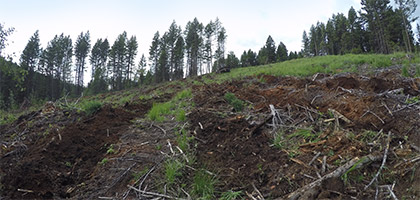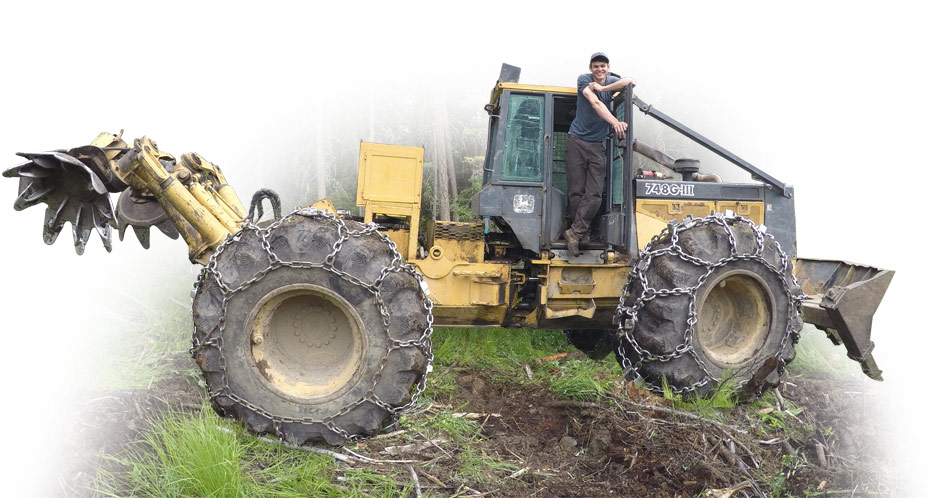Silviculture Services
Mechanical site preparation
The first step in forest management is properly preparing a site for reforestation. There are four ways we can get your block ready for planting:
- Disk Trenching
- Mounding/Pilling
- Chain Dragging
- Overstory Removal
Disc Trenching
 We offer Disc trenching throughout northern B.C. and Alberta. Like ploughing a farmer’s field, a mechanical crawler pulls a disc trencher along behind it, digging into the earth and creating a long row of trenching. Disc trenching is an effective scarification method to aid forestry management and can be applied on most sites, even on stony soils.
We offer Disc trenching throughout northern B.C. and Alberta. Like ploughing a farmer’s field, a mechanical crawler pulls a disc trencher along behind it, digging into the earth and creating a long row of trenching. Disc trenching is an effective scarification method to aid forestry management and can be applied on most sites, even on stony soils.
Scarifying the block with the disk trencher, aligns slash (refuse trees, bushes, etc.), exposing mineral soil,allowing hand planters easier to access the ground. This creates easy microsites for planters, thus reducing the cost of planting. The trench is matched by a berm of exposed mineral soil. This allows foresters and planters the choice of three distinct microsites in which to plant: the trench, the hinge. and the berm.
- The Hinge – This is commonly the microsite of choice, offering a compromise between the positive aspects of both the berm and the trench. By planting properly on the hinge, root systems are surrounded by organic matter which decreases the chance of frost heaves and increases the nutrients the seedling has access to.
- The Trench – This is a more common placement in southern B.C. where the increased access to water is desired. It also protects the tree from unfavourable winter conditions.
- The Berm – this is the most effective microsite for a wet site. It is also the most desirable of the three if it has a high component of well decomposed organic material and the area is reasonably wet, the risk of drought on the berm and the risk of flooding are mitigated. Usually, however, mounding is done for this reason, and is better for wetter areas.
Disc Trenching has been proven an effective tool of forest management and reforestation, helping trees to grow faster and stronger.

Excavator Mounding, Piling
Excavator mounding, and piling, is an important aspect of forest management. We offer the service throughout northern B.C. and Alberta.
Mounding
With an excavator, mineral soil is exposed in small mounds about 30cm high and 50cm wide, allowing hand planters to find prime, elevated microsites to plant their tree plugs. The machine operator correctly spaces the mounds to allow for perfect distance between trees.
There are three unique mounding types:
- Inverted hummus mounds– underlying soil and forest floor are scooped and placed upside down and on top of the forest floor.
- Mineral mounds– after scalping away forest floor, piles of free mineral soil are placed on top of exposed mineral soil surface.
- Mixed mounds– a combination of forest floor layers and mineral soil is tilled, mixed, and scooped up, then poured on top of either undisturbed or scalped forest floor.
Mounding is more commonly used on moderately moist to moist sites with limited stoniness. The raised microsite created by mounding can promote:
- Increased rooting zone temperatures
- Rooting in rich organic matter zones
- Improved soil drainage on wetter sites
- Enhanced aeration in certain soils (wet, clay, compacted)
- Decreased competition with neighbouring vegetation
Piling
We also offer excavator piling, which is useful for blocks where there is an over abundance of slash that makes it impossible to plant effectively. We clear the slash with an excavator, and pile it for convenient burning, allowing planters easier access to the forest floor.
Chain Dragging
Effective both as a means of aiding natural regeneration, and breaking up and dispersing slash, which mitigates danger on site, we take on chain dragging contracts throughout Alberta and Northern B.C..
If there are enough cones (viable seeds) on the ground it is possible, with proper technique, to utilize the natural occurring seeds in your forest management. To ensure these seeds have access both to the required soil and the sun, so they grow to meet governmental, forest management guidelines, drag scarification is recommended.
Chain dragging has proven to be an effective way of scarifying the ground in preparation for the seedlings. To properly prepare the ground, a skidder will pull a massive set of chains with links ranging from 8 to 55kgs depending on the depth of the forest floor. The chains create scarifier rows in the earth to enhance seed to mineral soil contact. This is most effective if done in the first season after logging, before or during the heat of summer. After the heat of summer is finished, the benefits of chain dragging for natural regeneration drops. And after the first season, chain dragging is only useful for risk management.
Due to the simplicity of chain dragging for natural regeneration, with only one equipment operator required, it is a cost-effective forest management technique.
Knockdown and Pile (Overstory Removal)
An important part of forest management, overstory removal and piling prepares the block for planters, making it safe for workers on the ground, and allows unfiltered sunlight to get to seedlings. We offer overstory removal throughout northern B.C. and Alberta.
When a fire rips through a forest, the area can have trouble regenerating because of an overcrowding of burned, standing timber. These damaged trees are dead and not viable for harvest. This creates crowding on the block for new seedlings, and makes it unsafe for planters due to the risk of the trees falling. To make way for new trees and to make the block safer for planters, the trees must be knocked down. After felling the standing timber, we pile them for convenient burning. This clearing allows for new, uninterrupted, uncompetitive growth with any other vegetation.

Can we help you with forest management?
